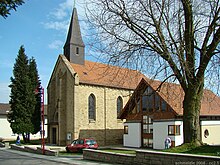St. Margareta (Eschelbach)
The Catholic Church of St. Margareta in Eschelbach , a district of the large district town of Sinsheim in the Rhein-Neckar district in northern Baden-Württemberg , was built in 1894 in a neo-Gothic style and essentially still has its original furnishings.
location
The church stands on the south side of Klammenstraße running west through the village at the transition from the old town center to the newer residential development.
history
After the reformation of the place by Hans von Hirschhorn in 1555, the population was initially purely Protestant before the first Catholics were able to settle in Eschelbach in the early 18th century. The emerging community became a branch of the parish in Balzfeld and held its first services in the town hall of Eschelbach. In 1870 the Eschelbach Catholics were assigned to the parish of Eichtersheim . Around 1890 there were over 200 Catholics in the village and plans to build their own church, for which a plot of land in In der Clammen was purchased.
The building permit was issued on August 28, 1893, and construction began shortly afterwards. Already in the year of construction in 1894 cracks and signs of subsidence appeared on the building, and a chimney had been installed incorrectly. In 1898 the community asked the Archbishop's Building Office to inspect the building because of the deficiencies. In 1899 the chapel could not be entered in stormy weather due to the risk of collapse, and the citizens also wanted the bell tower to be changed. In 1900 the construction defects were then remedied by extensive measures.
When the Catholic community grew rapidly after the Second World War , the sacristy was expanded in 1969/70 to include an addition for a choir, acolytes and library, which was enlarged again in 1989. In the course of the construction work in 1969, the church also received its current roof turret.
Bells
The church received two bells from the foundry Benjamin Grüninger Söhne in Villingen in 1894. One of these bells had to be delivered during the First World War, whereupon a replacement bell with the strike tone a '', a diameter of 43 cm and a weight of 47 kg was cast by Grüninger in 1925 . After another bell delivery in World War II, the chapel received two new bronze bells from Friedrich Wilhelm Schilling in Heidelberg in 1951 . The Marienglocke has the strike tone f '', a diameter of 57.4 cm and a weight of 110 kg. Her inscription reads HOLY MARY PLEASE FOR US . The Joseph bell has the strike sound as '', a diameter of 47 cm and a weight of 61 kg. Their inscription reads HL. JOSEPH PLEASE FOR US . When the roof ridge was rebuilt in 1969, a third bell was added to the bell. This third bell from 1969, also cast by Schilling, has the strike tone es '', a diameter of 64 cm and a weight of 180 kg. Your inscription reads A 1969 D .
Individual evidence
literature
- Norbert Jung: ihesvs maria + ano + m + cccc + xli - A contribution to the history of bells in the city of Sinsheim , Heilbronn 2009, p. 21/22.
Web links
Coordinates: 49 ° 15 ′ 2.6 ″ N , 8 ° 46 ′ 52.4 ″ E
